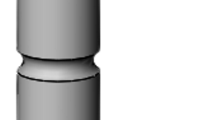Abstract
The crack initiation site and the corresponding incubation time were determined as a function of notch radius in 4340 steel for both internally and externally supplied hydrogen. The source of hydrogen was found to affect both the crack nucleation site and the incubation time. Hydrogen cracking in cathodically charged 4340 steel initiated near the elastic-plastic boundary with incubation times which exhibited a linear dependence on notch radius. Hydrogen cracking in an aqueous solution initiated near the notch surface with incubation times which were relatively independent of notch radius. Short time diffusional flow models which include a stress dependent critical hydrogen concentration were found to predict incubation times reasonably for internally supplied hydrogen. Cherepanov's solution for the diffusion at the tip of a semi-infinite linear slit when applied in the context of a finite notch root radii problem was found to predict incubation times adequately for externally supplied hydrogen.
Similar content being viewed by others
References
R. P. Fromberg, W. J. Barnett, and A. R. Troiano:Trans. ASM, 1955, vol. 47, p. 892.
H.H. Johnson, J.G. Morlet, and A. R. Troiano:Trans. TMS-A1ME, 1958, vol. 212, p. 528.
E. A. Steigerwald, R.W. Schaller, and A. R. Troiano:Trans. TMS-AIME, 1960, vol. 218, p. 832.
A.R. Troiano:Trans. ASM, 1960, vol. 52, p. 54.
W.W. Gerberich:Hydrogen in Metals, ASM, Metals Park, OH, 1974, pp. 115–47.
W.W. Gerberich and Y.T. Chen:Metall. Trans. A, 1975, vol. 6A, p. 271.
W. W. Gerberich, Y. T. Chen, and C. St. John:Metall. Trans. A, 1975, vol. 6A, p. 1485.
C. St. John and W. W. Gerberich:Metall. Trans., 1973, vol. 4, p. 589.
C.F. Barth and E.A. Steigerwald:Metall. Trans., 1970, vol. 1, p. 3451.
H.P. VanLeeuwen:Corrosion, 1973, vol. 29, p. 197.
H.P. VanLeeuwen:Corrosion, 1975, vol. 31, p. 42.
H.P. VanLeeuwen:Corrosion, 1975, vol. 31, p. 154.
H.P. VanLeeuwen:Eng. Fract. Mech., 1974, vol. 6, p. 141.
A.J. Wang:Quart. Appl. Math., 1954, vol. 11, p. 427.
P. C. Paris and G. C. Sih:Fracture Toughness Testing and Its Applications, ASTM STP,ASTM, Philadelphia,PA, 1965, vol. 381, pp. 30–81.
M. Creager and P. C. Paris:Int. J. Fract. Mech., 1967, vol. 3, p. 247.
W. W. Gerberich, J. Garry, and J.F. Lessar:Effect of Hydrogen on Behavior of Materials, TMS-AIME, New York, NY, 1976, pp. 70–82.
A. R. Jack and A. T. Price:Int. J. Fract. Mech., 1970, vol. 6, p. 401.
J.M. Barsom and R. C. McNicol:Fracture Toughness and Slow-Stable Cracking, ASTM STP, ASTM, Philadelphia, PA, 1974, vol. 559, pp. 183–204.
W. G. Clark, Jr.,Fracture Toughness and Slow-Stable Cracking, ASTM STP, ASTM, Philadelphia, PA, 1974, vol. 559, pp. 205–24.
R.A. Oriani:Bunsen-Gesellshaft Phys.Chem., 1972, vol. 76, p. 848.
C.J. McMahon, Jr., C.L. Briant, and S.K. Banerji:Fracture 1977, Pergamon Press, New York, NY, 1977, p. 363.
M. Iino:Eng. Fract. Mech., 1978, vol. 10, p. 1.
W. W. Gerberich, K. Jatavallabuhla, K. A. Peterson, and C. L. Jensen: “Hydrogen-induced fracture phenomena in a bcc titanium alloy,” Fifth International Conference on Fracture, Cannes, France, 1981.
G. P. Cherepanov:Mechanics of Brittle Fracture, McGraw-Hill, Inc. (translated by R. De wit and W. Cooley from Nanka Press, Moscow, 1977), New York, NY, 1979, p. 410.
Author information
Authors and Affiliations
Rights and permissions
About this article
Cite this article
Page, R.A., Gerberich, W.W. The effect of hydrogen source on crack initiation in 4340 steel. Metall Trans A 13, 305–311 (1982). https://doi.org/10.1007/BF02643321
Received:
Issue Date:
DOI: https://doi.org/10.1007/BF02643321




